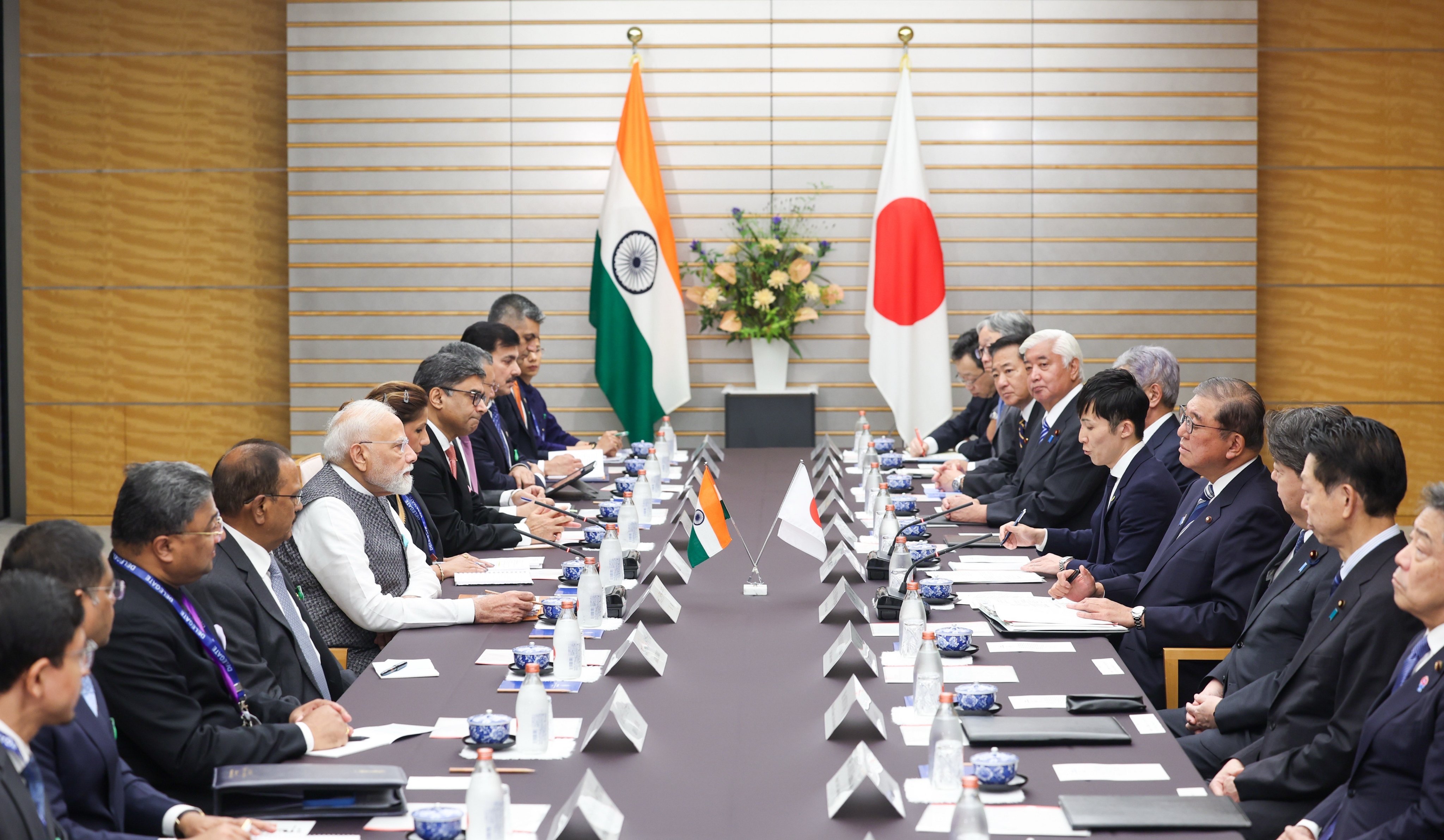India, Japan Cement Strategic Ties with 10-Year Roadmap, Security Declaration, and $67 Billion Investment Target
India's Ministry of External Affairs held a special press briefing in Tokyo on August 29 to outline the outcomes of Prime Minister Narendra Modi’s visit to Japan for the 15th Annual Summit with Japanese Prime Minister Shigeru Ishiba.
 |
| Image Source: PM NaMo |
Following Prime Minister Modi’s arrival in Tokyo and participation in the India–Japan Economic Forum earlier in the day, he held a series of high-level meetings, including delegation-level talks with Prime Minister Ishiba and bilateral interactions with former Prime Ministers Yoshihide Suga and Fumio Kishida.
The leaders witnessed the exchange of multiple agreements and jointly addressed the press, with Prime Minister Ishiba hosting a formal dinner for his Indian counterpart.
The Foreign Secretary described the bilateral relationship as “one of the most trusted friendships” India holds, founded on a shared commitment to a stable, rules-based international order.
At the core of the summit outcomes was the exchange of a Joint Vision Document for the Next Decade -- a strategic roadmap structured around eight pillars of cooperation: economic ties, economic security, ecological sustainability, technology and innovation, health, people-to-people exchanges, mobility, and partnerships between Indian states and Japanese prefectures.
Alongside this, the two nations adopted a Joint Declaration on Security Cooperation, providing a framework for enhanced defence and security coordination, including new institutional dialogues between the national security advisors and joint military staffs of both countries.
The declaration broadens the scope of bilateral security collaboration to include cyber security, counterterrorism, defence industry R&D, and multilateral engagement.
The Foreign Secretary announced a major headline commitment: a new investment target of 10 trillion Japanese Yen (approximately $67 billion) in private sector investment from Japan to India over the next decade.
He noted that Japanese companies have already signed 150 MoUs with Indian counterparts over the last two years, across sectors such as automotive, aerospace, energy, semiconductors, and human resources, amounting to over $13 billion in cumulative investment.
This was described as a strong indicator of private sector confidence in India’s business environment.
Among the agreements signed was the India–Japan Joint Crediting Mechanism, which enables Japanese companies to invest in decarbonisation technologies and count these towards bilateral climate goals.
This forms a key component of a broader green partnership that also includes the newly launched Sustainable Fuel Initiative and Battery Supply Chain Partnership.
The two sides also issued an Economic Security Fact Sheet and launched a formal Economic Security Initiative, identifying five strategic sectors for joint focus: semiconductors, critical minerals, pharmaceuticals, ICT (especially telecom), and clean energy.
Foreign Secretary Misri also highlighted the launch of the Japan–India Artificial Intelligence Initiative, aimed at collaborative work on large language models, AI infrastructure such as data centres, and regulatory frameworks.
Prime Minister Modi has extended an invitation to Prime Minister Ishiba to attend the AI Impact Summit being hosted by India in February 2026. Additional digital cooperation was formalised through the India–Japan Digital Partnership 2.0, focused on Digital Public Infrastructure, digital talent exchange, and joint R&D.
The two sides also agreed on an ambitious human resources action plan, targeting a two-way exchange of 500,000 individuals over five years. This includes the placement of 50,000 skilled and semi-skilled Indian professionals in Japanese sectors experiencing labour shortages.
The Prime Minister is scheduled to address the Governors of several Japanese prefectures in Tokyo, with an emphasis on expanding subnational cooperation through new forums such as the India–Kansai and India–Kyushu Business Forums.
India and Japan reaffirmed their commitment to a free, open, peaceful, and inclusive Indo-Pacific, with shared views on countering terrorism, securing maritime domains, and cooperating on defence innovation.
While leaders discussed global developments including tariffs and supply chain disruptions, Foreign Secretary Misri clarified that the focus remained on bilateral mechanisms to promote resilient supply chains and diversified sourcing, rather than third-party disputes.
Several other agreements were also announced, including an implementing arrangement between ISRO and JAXA on the Chandrayaan-5 LUPEX mission, a landmark space collaboration aiming to explore the lunar south pole.
The MoU on Mineral Resources will facilitate deeper cooperation between Japan’s technological capabilities and India’s resource base. Additional agreements spanned digital technologies, diplomatic training, cultural exchange, and environmental cooperation.
The two leaders also reviewed the progress of the Mumbai–Ahmedabad high-speed rail project and launched the Next Generation Mobility Partnership, targeting collaboration in infrastructure, ports, shipping, aviation, and smart logistics.
Prime Minister Modi is expected to visit Sendai in Miyagi Prefecture and the Tokyo Electron Factory, a global leader in semiconductor equipment, as part of the concluding leg of his Japan trip.
Summing up the engagement, Foreign Secretary Misri described the summit as a moment of “greater ambition, stronger vision, and a reaffirmation of the strength of the all-important India–Japan partnership.”
